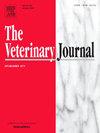牛髋臼骨折诊断及保守治疗效果的回顾性评价。
IF 3.1
2区 农林科学
Q1 VETERINARY SCIENCES
引用次数: 0
摘要
牛髋臼骨折是罕见的,其预后通常被认为是不利的。本回顾性研究的目的是确定2016年1月至2024年11月苏黎世大学兽医医院反刍动物外科收治的36头牛37例髋臼骨折的诊断、治疗和结果。所有牛均为母牛,多数为幼牛(平均年龄13个月;范围:9 - 92个月)。跛行评分中位数为3/5(范围1 - 5/5),所有牛均能站立。髋臼骨折的诊断是基于临床和影像学表现。辅助超声检查21例。单纯性骨折最常见,25头牛发生;一头小母牛双侧单纯性髋臼骨折伴坐骨受累。4头牛发生1 - 2个额外碎片骨折,7头牛发生粉碎性骨折。治疗方法为闭式休息3个月。根据饲主信息,大多数牛(31/36,86.0%)在入院后3个月健全,34/36(94.4%)在入院后6个月无跛行。截至2024年11月底,大多数牛(27/36)自入院以来至少产过一次犊,24/25头牛(现有资料)在无人协助下产犊。在研究结束时,36头奶牛中有21头仍在生产。根据我们的研究结果,牛髋臼骨折的预后良好。保守治疗包括摊位休息和疼痛管理是直截了当的,提供了良好的长期结果。本文章由计算机程序翻译,如有差异,请以英文原文为准。
Retrospective evaluation of the diagnosis of acetabular fracture in cattle and the outcome after conservative treatment
Acetabular fractures are rare in cattle, and their prognosis has generally been considered unfavourable. The goal of this retrospective study was to determine the diagnosis, treatment, and outcome in 36 cattle with 37 acetabular fractures presented to the Unit of Ruminant Surgery, University of Zurich Veterinary Hospital, from January 2016 to November 2024. All cattle were female and mostly young (13 months, median age; range, 9 – 92 months). The median lameness score was 3/5 (range 1 – 5/5), and all cattle could stand. A diagnosis of acetabular fracture was based on clinical and radiographic findings. Adjunctive ultrasonography was used in 21 cases. Simple fractures were the most common and occurred in 25 cattle; one heifer had bilateral simple acetabular fractures with ischial involvement. Fractures with 1–2 additional fragments occurred in four cattle, and seven animals had comminuted fractures. Treatment consisted of stall rest for 3 months. Based on owner information, most cattle (31/36, 86.0 %) were sound after 3 months, and 34/36 (94.4 %) were free of lameness 6 months after admission. By the end of November 2024, most cattle (27/36) had calved at least once since admission to our clinic, and 24/25 cows (available information) had unassisted calvings. Twenty-one of the 36 cows were still productive at the end of the study. Based on our findings, the prognosis of acetabular fractures in cattle is favourable. Conservative treatment consisting of stall rest and pain management is straightforward, providing a good long-term outcome.
求助全文
通过发布文献求助,成功后即可免费获取论文全文。
去求助
来源期刊

Veterinary journal
农林科学-兽医学
CiteScore
4.10
自引率
4.50%
发文量
79
审稿时长
40 days
期刊介绍:
The Veterinary Journal (established 1875) publishes worldwide contributions on all aspects of veterinary science and its related subjects. It provides regular book reviews and a short communications section. The journal regularly commissions topical reviews and commentaries on features of major importance. Research areas include infectious diseases, applied biochemistry, parasitology, endocrinology, microbiology, immunology, pathology, pharmacology, physiology, molecular biology, immunogenetics, surgery, ophthalmology, dermatology and oncology.
 求助内容:
求助内容: 应助结果提醒方式:
应助结果提醒方式:


